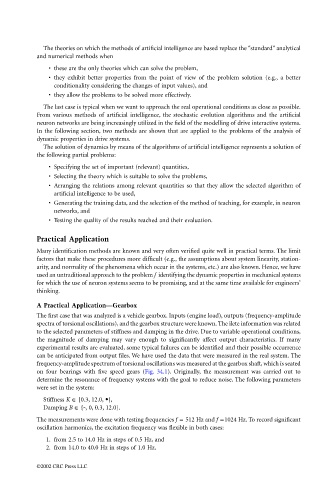Page 1014 - The Mechatronics Handbook
P. 1014
The theories on which the methods of artificial intelligence are based replace the “standard” analytical
and numerical methods when
• these are the only theories which can solve the problem,
• they exhibit better properties from the point of view of the problem solution (e.g., a better
conditionality considering the changes of input values), and
• they allow the problems to be solved more effectively.
The last case is typical when we want to approach the real operational conditions as close as possible.
From various methods of artificial intelligence, the stochastic evolution algorithms and the artificial
neuron networks are being increasingly utilized in the field of the modelling of drive interactive systems.
In the following section, two methods are shown that are applied to the problems of the analysis of
dynamic properties in drive systems.
The solution of dynamics by means of the algorithms of artificial intelligence represents a solution of
the following partial problems:
• Specifying the set of important (relevant) quantities,
• Selecting the theory which is suitable to solve the problems,
• Arranging the relations among relevant quantities so that they allow the selected algorithm of
artificial intelligence to be used,
• Generating the training data, and the selection of the method of teaching, for example, in neuron
networks, and
• Testing the quality of the results reached and their evaluation.
Practical Application
Many identification methods are known and very often verified quite well in practical terms. The limit
factors that make these procedures more difficult (e.g., the assumptions about system linearity, station-
arity, and normality of the phenomena which occur in the systems, etc.) are also known. Hence, we have
used an untraditional approach to the problem f identifying the dynamic properties in mechanical systems
for which the use of neuron systems seems to be promising, and at the same time available for engineers’
thinking.
A Practical Application—Gearbox
The first case that was analyzed is a vehicle gearbox. Inputs (engine load), outputs (frequency-amplitude
spectra of torsional oscillations), and the gearbox structure were known. The ilete information was related
to the selected parameters of stiffness and damping in the drive. Due to variable operational conditions,
the magnitude of damping may vary enough to significantly affect output characteristics. If many
experimental results are evaluated, some typical failures can be identified and their possible occurrence
can be anticipated from output files. We have used the data that were measured in the real system. The
frequency-amplitude spectrum of torsional oscillations was measured at the gearbox shaft, which is seated
on four bearings with five speed gears (Fig. 34.1). Originally, the measurement was carried out to
determine the resonance of frequency systems with the goal to reduce noise. The following parameters
were set in the system:
Stiffness K ∈ {0.3, 12.0, •},
Damping B ∈ {-, 0, 0.3, 12.0}.
The measurements were done with testing frequencies f = 512 Hz and f =1024 Hz. To record significant
oscillation harmonics, the excitation frequency was flexible in both cases:
1. from 2.5 to 14.0 Hz in steps of 0.5 Hz, and
2. from 14.0 to 40.0 Hz in steps of 1.0 Hz.
©2002 CRC Press LLC

